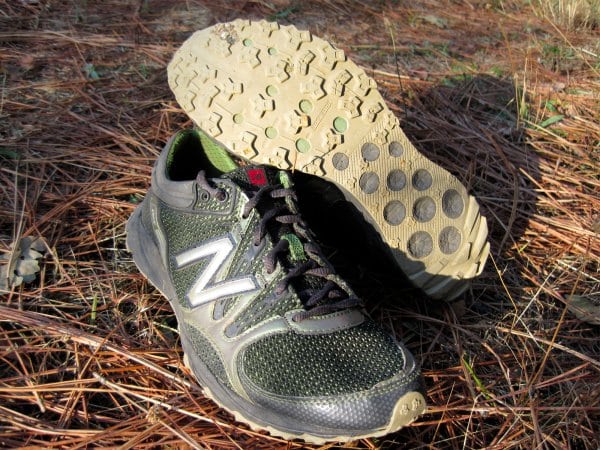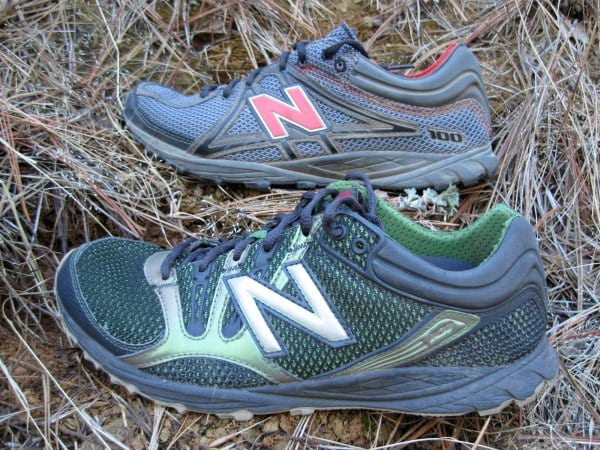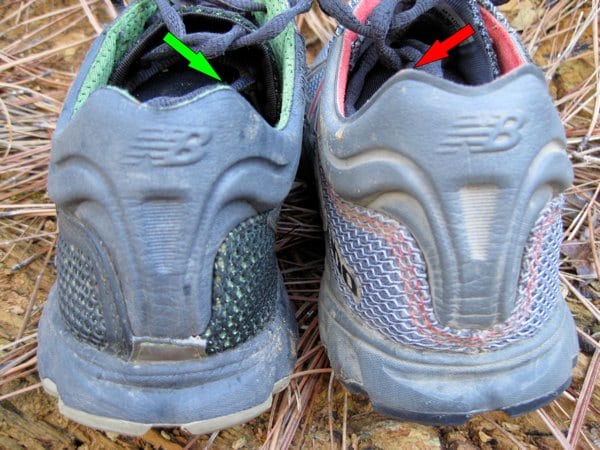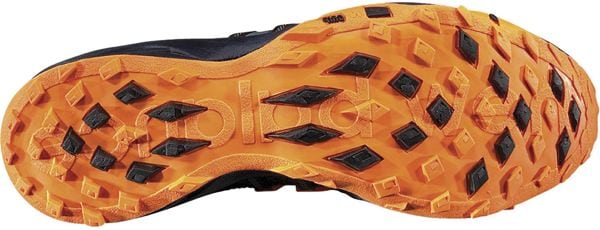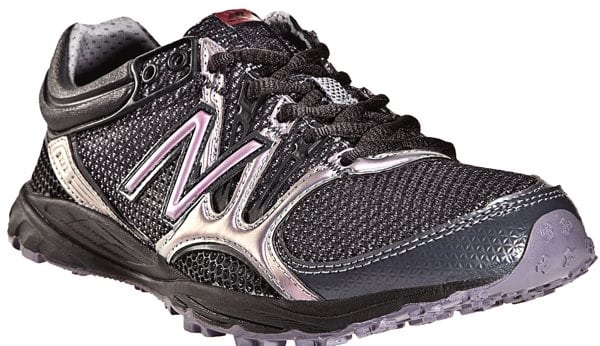Our Favorite Trail Running Shoes
To learn about our current favorite trail running shoes, check out our Best Trail Running Shoes article.
New Balance MT101 Review
 I’m an unfit Popeye and the New Balance MT101s are my spinach. The year’s not quite over, but I can’t imagine anything but the MT101 as my favorite new shoe of the year. Seriously, that’s no hyperbole. For anything shorter than marathon, there’s no other shoe I’d rather run in right now. The New Balance MT101/WT101 (MT101 from here on) is light, low to the ground, and fits like a glove. All the issues I had with the original MT100 have been ironed out.
I’m an unfit Popeye and the New Balance MT101s are my spinach. The year’s not quite over, but I can’t imagine anything but the MT101 as my favorite new shoe of the year. Seriously, that’s no hyperbole. For anything shorter than marathon, there’s no other shoe I’d rather run in right now. The New Balance MT101/WT101 (MT101 from here on) is light, low to the ground, and fits like a glove. All the issues I had with the original MT100 have been ironed out.
Since being launched last autumn, the New Balance MT100 has been the talk to the minimalist trail shoe world. (“Barefoot shoes” are their own thing.) Originally designed with the help of Anton Krupicka and the Skaggs brothers, there aren’t a lot of extras on these shoes. The MT101 is merely an evolution of the MT100, but the changes that were made make it a much better shoe.
[If you enjoy this review, please consider subscribing to iRunFar via RSS or via email. You can also follow iRunFar on Facebook and Twitter.]
Here’s a summary of the changes before jumping into an in-depth review:
- Better foot lockdown by the addition of midfoot and rearfoot overlays
- Improved ankle collar construction that saves your Achilles
- Slightly more expensive – it costs all of $5 more
- More flexible rockplate
- Slightly heavier at 7.48 ounces versus 7.09 ounces for a US men’s 9
- Less odiferous glue
Below, we’ll examine the MT101’s upper, midsole, outsole, and weight before taking a look at my own experience with the shoe. Read on to find out why I love the MT101 so much!
[BTW, if you have an interest in minimalist shoes, New Balance, or Anton Krupicka, check out our preview of the forthcoming New Balance Minimus line designed with input from Anton.
Upper
New Balance made its two biggest improvements to the MT100 by adding overlays and fixing the ankle collar in the MT101. In addition, they tweaked the tongue a bit. Otherwise, it’s the same great upper as the MT100. Here’s more on the upper.
Additional Overlays
The MT upper continues to be primarily mesh backed by lightweight fabric, but now with significant and well-deserved additions. In our MT100 review, Travis Liles noted, “the upper… does not offer much lateral support, which can be problematic on technical or switchbacking trail.” This observation was echoed by many others.
In response, New Balance completely redesigned the upper’s overlays. Most notable is a significant metatarsal wrap that expands from an inch wide at its attachment point in the center of the arch to five inches wide at the top of the shoe. That results in a wrap stretching from the foremost eyelets to one and a half inches back on the ankle collar. This is a huge improvement that really locks down the entire foot as well as providing a small amount of support.
On the lateral (outside) portion of the midfoot upper, New Balance added one midsole-to-eyelet band (from four to five), but, more significantly, the company spread out the connection points of those bands from two center eyelets to five eyelets, which gives broader metarsal lockdown.
Finally, New Balance added both a medial (inside) and a lateral band connecting the midsole and the ankle collar. This change, along with all the others, makes for a much cleaner ride on technical terrain. The MT101 is better connected to your foot, which means you are better connected to the trail.
[Update: Following 2 paragraphs added 11/20/10] In investigating the MT101 even more closely, I noticed a barely detectable polymer mesh over the fabric mesh on the lateral side of the heel and ball of the foot. I contacted New Balance to get the scoop on this. I asked, “Is the purpose of this polymer mesh primarily to provide structure to the upper, to prevent blowout of the fabric mesh in these areas, or something else?” Product Manager Brian Gothie responded,
You are correct on both assumptions. Tony was blowing out the MT100 right at that spot on the lateral forefoot so we needed to strengthen it. Also, felt like we needed a way to add some structure to the heel and this did so in a lightweight, “barely detectable” manner.
Ankle Collar
With the MT100, a small, but significant number of runners experienced severe chafing of the Achilles tendon area. I was one of those sufferers in the MT100 when the skin over my Achilles sawed to pieces in less than 3 sockless miles. For some, the problem even persisted while wearing running socks! The culprit? A 2-mm high ridge of thin EVA at the top of the ankle collar. That ridge served no purpose and was merely a relic from the manufacturing process.
Well, I’m happy to report that New Balance successfully revamped its manufacturing process. I can now deem the MT100’s ankle collar problem completely eliminated in the MT101. Sure, I still get some light rubbing in the Achilles notch, but it’s minor and what I’d expect given these are the only shoes I’ll wear sockless.
The Tongue
The MT100’s tongue was a single layer of the fabric-backed mesh that is used throughout the rest of the shoe. This thin mesh had a tendency to fold and collapse. New Balance found a way to provide structure with a minimal addition of material. On the rear of the tongue, they sewed on a thin, second layer of fabric that extends two inches down the backside of the tongue at the tongue’s edges while tapering to an inch at the center of the tongue. On the front of the tongue, New Balance bonded a half inch-wide ribbon that extends vertically two inches down the center of the tongue. These two additions can hardly weigh a thing, but they do keep the tongue laying flat against the top of your feet.
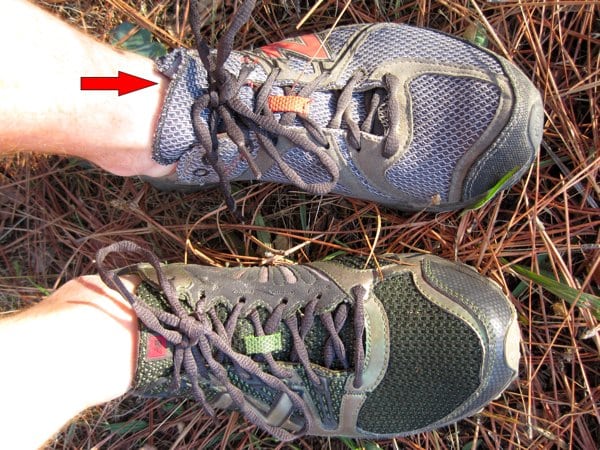
The tongues of the New Balance MT100 (top) and MT101 (bottom). I did not adjust either before taking this picture.
Other Upper Features
The MT101 still has the slipper like feel of the MT100, while retaining plenty of toe box wiggle room. The mesh upper is highly breathable, but does let in quite a bit of dust. The MT101 also retains the “sausage-like” Sure Laces.
Midsole
If you can feel an underfoot difference between the MT100 and MT101 you’ve got some pretty sensitive feet.
As with the MT100, the MT101 lacks a post for pronation control. However, the midsole is raised on both the inside and outside of the midfoot, which provides a modest amount of support.
Once again, there’s a Rockstop TPU-rockplate sandwiched between the outsole and midsole that offers decent push-through protection in the forefoot and midfoot. New Balance made the MT101’s rockplate slightly less dense, which results in more forefoot flexibility. While I’ve not been able to feel the difference in flexibility while running (Yes, I’ve run with the MT100 on one foot and the MT101 on the other.), the MT101 is hands down the more flexible shoe in manual testing.
I don’t feel that the decreased rockplate density detracts from its push-through protection. In fact, in side-by-side “jumping ’round the yard” tests, I felt the MT101 offered better rock protection as the MT100.
One other thing… according to some, the MT100 had a “horrible, long-lasting VOC stench.” This smell came from the cement that glued the rockplate to the midsole. New Balance corrected this problem with the MT101.
Outsole
New Balance didn’t change the MT100’s trail-specific outsole one bit for the MT101. Why mess with a good thing? The outsole is a scant 2mm (or so) thick at the midfoot with lugs ranging from 1 to 3 mm in the forefoot and midfoot with 5 mm lugs in the heel. There are still circular cutouts in the outsole to reduce weight. These cutouts expose the Rockstop rockplate in the forefoot and midsole foam from the midfoot through the heel.
The MT101’s outsole remains perfect for packed dirt trails; however, it’s not the shoe of choice on sloppy trails. That said, the heel does provide some grip, which is why Anton didn’t shave it off before the snowy start of the 2010 Western States 100. I’ll note that, every once in a blue moon, a piece of pointy rock will stick into the heel’s exposed foam.
International Outsole
Note that in some international markets where trail runners demand more traction, such as the UK, New Balance uses a more aggressive NB 840 outsole for the MT101. (iRunFar contest winners will receive the US version no matter where they live.)
Weight (or lack thereof)
I found the light weight of these shoes to be exhilarating… especially, because I still consider the MT101s to be full-fledged, if stripped-down, shoes. My used MT101s in US men’s 9 weigh 7.48 ounces (212 grams). While that’s pretty darn light, it is a bit heavier than my used MT100s, which weigh in at 7.09 ounces (201 grams). Given that the MT101s still weigh in at less then 7.5 ounces, I can live with an extra 11 grams on each foot.
My Experience With the New Balance MT101s
As noted at the top, I love the MT101. I get to slip my feet into more trail shoes than I can keep track of and, at the moment, there’s no other shoe that I’d rather slip into for a quick run. These shoes feel fast and make me want to run fast. In fact, while I’m not sure if it’s a placebo effect or my need to be a midfoot runner in the MT101s, I think they do make me run faster. When I want to bust out of my running doldrums, the MT101s are a stiff breeze at my back.
In truth, most of my running in the MT101s has been on a roughly even mix of paved roads, dirt roads with some gravel, and soft shoulders. I admit I love running short road runs in these shoes. No, they are not well-cushioned, but I like the firmness. I can’t see myself ever logging 20 mile all-pavement runs in them, but I have logged up to 5 or 6 miles of pavement in a run without regretting it.
The MT101s also kick butt in the water. The mesh upper instantly takes in water, but it also sheds it like a sieve. Plus, there’s not much in the shoe that can absorb liquid. Within a minute of completing a recent half hour run in the rain, I weighed my MT101s and they weighed in at under 10 ounces. They picked up a scant 2.3 ounces (65 grams) of water for a wet foot total of 9.74 ounces (277 grams). Meet my new stormy weather trail shoes!
In my few proper trail runs, I forced sharp turns, leaped onto pointy boulders, and otherwise pushed the shoes as best I could. They’ve not failed me yet. I do find that, if I’ve not worn them in a while, I find gravely roads to be intermittently painful. However, over a series of runs, I quickly adjust to block out this transient, nuisance-level pain.
Both the MT100 and MT101 have a 10mm drop from heel to toe. Although the drop is a little less than the 11-12mm drop found in many shoes, it is not small. The numbers would lead me to believe that I could train at will in the MT101s. That would be wrong. If you have been a heel striker or have suffered from foot or lower leg issues, please slowly transition to the MT101! The MT101 has a much lower than average 18mm heel height and an 8mm toe height, so there’s not much cushioning. As a result, you will run more on your toes than many of us are used to. The shoes are an awesome tool to help build foot and leg strength and I believe they would make a great transition shoe for long-time runners who later plan on incorporating barefoot running into their running regimen.
As an aside, I speak of the above gradual progression from experience. In November 2009, I was hit with plantar fasciitis. I spent 6 months in extremely supportive shoes while mostly sticking to relatively flat runs. By the time I was symptom free in May 2010, my calves had atrophied from the lack of miles and hills. This summer, even my initial, short 4-5 mile runs in the MT101s left my feet and calves tired the next day. I loved the shoes, but couldn’t wear them more often than every other day and for no more than 5 miles at a time. A few months later, I’ve now worn them for up to 10 miles at a time and I’m holding up much better on 6-8 mile runs in the MT101s. They remain, at most, an every other day shoe. I look forward to continued progression with my new favorite trail running shoes, the New Balance MT101s.
Price and Availability
The MT101s are available now! It’s true that New Balance did up the MSRP $5 from the MT100s to the MT101s, but I think MT1010s are still a steal at $79.95! Note that you can find the MT101 and WT101 for $74.95, the same as previous MSRP for the MT100 and WT100.
Call for Comments/Questions
While the contest is as simple as noted above, we’d love some more info from our readers. If you’ve previously worn the MT100 or WT100 or if you’ve had a chance to try the MT101/WT101, please let us know what you like about them.
As always, please ask any questions you might have about the shoes.
New Balance MT101/WT101 Giveaway
We held a worldwide contest to give away five pairs of the MT101/WT101. Winners were announced here.
